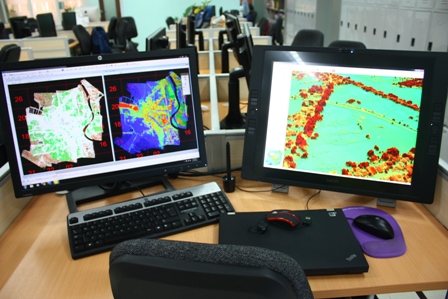On their maiden flight, two light planes took flight carrying instruments to map Philippine river basins and flood-prone areas. The University of the Philippines (UP) in partnership with the Department of Science and Technology (DOST) launched “Project DREAM” (or Disaster Risk and Exposure Assessment for Mitigation's LiDAR-equipped planes) on November 22, at Clark Air Base, in Angeles City, Pampanga.  Two T-206 CESSNA planes equipped with LiDAR ALTM (Airborne Laser Terrain Mapper) Aquarius were commissioned to map at least 17 major river basins all over the country. These included the Marikina-Pasig River system and the Cagayan de Oro river. LiDAR ALTM costs around P200 thousand. The entire project costs around P1.6 billion, according to DOST. LiDAR technology, or Light Detection and Ranging, is a state-of-the-art surveying technology, similar to radars, that determines the range, height, and direction of objects. The instrument fires laser pulses on the surface it surveys at around 150,000 pulse per second. Its sensor measures the amount of time each pulse takes to bounce back and the LiDAR calculates the distance between itself and the target. LiDAR technology is capable of simultaneous land and water mapping through 3D imagery at a very rapid rate. It is also considered to be the most effective technique for flood hazard mapping.
Two T-206 CESSNA planes equipped with LiDAR ALTM (Airborne Laser Terrain Mapper) Aquarius were commissioned to map at least 17 major river basins all over the country. These included the Marikina-Pasig River system and the Cagayan de Oro river. LiDAR ALTM costs around P200 thousand. The entire project costs around P1.6 billion, according to DOST. LiDAR technology, or Light Detection and Ranging, is a state-of-the-art surveying technology, similar to radars, that determines the range, height, and direction of objects. The instrument fires laser pulses on the surface it surveys at around 150,000 pulse per second. Its sensor measures the amount of time each pulse takes to bounce back and the LiDAR calculates the distance between itself and the target. LiDAR technology is capable of simultaneous land and water mapping through 3D imagery at a very rapid rate. It is also considered to be the most effective technique for flood hazard mapping.
"
Ang isang lipad ng eroplano ay aabot ng apat na oras which is equivalent to 60-80 sq km.
May 200 GB na data
'yun." said DREAM leader Dr. Enrico Paringit during the flight. Paringit also said that they need 500 days to complete the project. But DREAM does not end there. On Nov. 23, DREAM office was inaugurated at the UP National Engineering Center. The office is equipped with computers capable of processing data coming from LiDAR instruments. In fact, DREAM consists of four components including; LiDAR data acquisition, processing, validation and flood modelling. The flood models DREAM will produce shall be available in the
Project NOAH website "If you look at current hazard maps, it says that 85 percent of our country is hazard prone.
Ibig sabihin ba, sa 15 percent
lang tayo magsisiksikan?" said Paringit, emphasizing the importance of accurate hazard maps for proper land use policies. Paringit also said in a statement that the 3D maps DREAM will produce can also be beneficial for other purposes such as forest inventory, environmental monitoring, fault line mapping, infrastructure planning, archaeological surveys, and agricultural assessment.
– KDM, GMA News 



